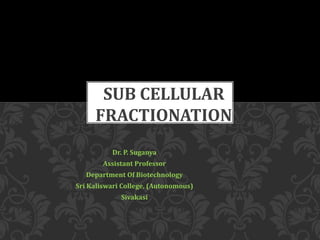Sub cellular fractionation
•Download as PPTX, PDF•
0 likes•114 views
centrifugation
Report
Share
Report
Share

Recommended
Recommended
What is
centrifugation?
Basic principle of
centrifugation
Interacting ForcesBioMedical Instrumentation-II What is centrifugation? Basic principle of ce...

BioMedical Instrumentation-II What is centrifugation? Basic principle of ce...The University of Lahore
More Related Content
Similar to Sub cellular fractionation
What is
centrifugation?
Basic principle of
centrifugation
Interacting ForcesBioMedical Instrumentation-II What is centrifugation? Basic principle of ce...

BioMedical Instrumentation-II What is centrifugation? Basic principle of ce...The University of Lahore
Similar to Sub cellular fractionation (20)
BioMedical Instrumentation-II What is centrifugation? Basic principle of ce...

BioMedical Instrumentation-II What is centrifugation? Basic principle of ce...
Centrifugation principle and types by Dr. Anurag Yadav

Centrifugation principle and types by Dr. Anurag Yadav
More from SuganyaPaulraj
More from SuganyaPaulraj (20)
Recently uploaded
Recently uploaded (20)
Botany krishna series 2nd semester Only Mcq type questions

Botany krishna series 2nd semester Only Mcq type questions
Disentangling the origin of chemical differences using GHOST

Disentangling the origin of chemical differences using GHOST
Formation of low mass protostars and their circumstellar disks

Formation of low mass protostars and their circumstellar disks
Asymmetry in the atmosphere of the ultra-hot Jupiter WASP-76 b

Asymmetry in the atmosphere of the ultra-hot Jupiter WASP-76 b
Recombination DNA Technology (Nucleic Acid Hybridization )

Recombination DNA Technology (Nucleic Acid Hybridization )
Creating and Analyzing Definitive Screening Designs

Creating and Analyzing Definitive Screening Designs
Nightside clouds and disequilibrium chemistry on the hot Jupiter WASP-43b

Nightside clouds and disequilibrium chemistry on the hot Jupiter WASP-43b
Stunning ➥8448380779▻ Call Girls In Panchshil Enclave Delhi NCR

Stunning ➥8448380779▻ Call Girls In Panchshil Enclave Delhi NCR
GUIDELINES ON SIMILAR BIOLOGICS Regulatory Requirements for Marketing Authori...

GUIDELINES ON SIMILAR BIOLOGICS Regulatory Requirements for Marketing Authori...
High Class Escorts in Hyderabad ₹7.5k Pick Up & Drop With Cash Payment 969456...

High Class Escorts in Hyderabad ₹7.5k Pick Up & Drop With Cash Payment 969456...
Chemical Tests; flame test, positive and negative ions test Edexcel Internati...

Chemical Tests; flame test, positive and negative ions test Edexcel Internati...
Discovery of an Accretion Streamer and a Slow Wide-angle Outflow around FUOri...

Discovery of an Accretion Streamer and a Slow Wide-angle Outflow around FUOri...
Recombinant DNA technology (Immunological screening)

Recombinant DNA technology (Immunological screening)
Pests of mustard_Identification_Management_Dr.UPR.pdf

Pests of mustard_Identification_Management_Dr.UPR.pdf
Sub cellular fractionation
- 1. Dr. P. Suganya Assistant Professor Department Of Biotechnology Sri Kaliswari College, (Autonomous) Sivakasi SUB CELLULAR FRACTIONATION
- 2. Cell fractionation is the process used to separate cellular components while preserving individual functions of each component. This is a method that was originally used to demonstrate the cellular location of various biochemical processes.
- 3. 1. Homogenization: The suspended cells are then disrupted by the process of homogenization. ... 2. Centrifugation:
- 6. CENTRIFUGE
- 7. Centriguge ia an apparatus- used to –separate particles –suspended in a solution- by centrifugal force Its works on – principle- centrifugation- operates- molecules based on their size & mass Centrifugation-Is a process- separation of particles- suspended in a solution- by centrifugal force CENTRIFUGE
- 8. The process of centrifugation relies on the perpendicular force created when a sample is rotated about a fixed point. The rate of centrifugation is dependent on the size and density of the particles present in the solution. DEFINITION
- 9. PRINCIPLE
- 11. The spinning produces a force called centrifugal force The centrifugal force causes the substances to move away from the axis more rapidly The movement of particles is called sedimentation. The particles settle because of gravity. The rate of movement of particles is called sedimentation rate. The sedimentation rate depends on the size& density of the particles. The larger and denser particles settle first. This is followed by smaller and less denser particles. PRINCIPLE
- 12. The sedimented particle is called pellet. The solution above the pellet is called supernatant. The particles settle down because of gravitational pull. The spinning increase the gravitational pull. The speed of centrifuge is expressed as rpm (resolutions per minutes or seconds) The greater the rpm, the greater will be the centrifugal force. The longer the radius of rotation, the greater will be the centrifugal force.
- 13. The rate of sedimentation depends on 1. The density of the particles 2. The size of the particles 3. The viscosity of the medium 4. The gravitational pull The gravitational field is generally denoted as RCF (Relative Centrifugal force) expressed in g units. The RCF depends on- 1. Number of revolutions per minute- rpm2 2. Radius of rotation-r 3. Gravitational Pull-g RCF (g Force)= 1.118 × 10-5 × r × (RPM)2 where r is the radius of the rotor (in centimeters), and RPM is the speed of the rotor in rotation per minute.
- 15. o Centrifuge is an apparatus used to separate particles by centrifugal force o The centrifuge consist of a motor and rotor. The motor makes the rotor to spin o The motor is fitted with horizontal rod or a disc containing holders for placing the tubes o The entire set up is kept in a container o The rotors are of two types namely angle type and swinging bucket type. o In angle type, the holders and sample tubes swing up and run horizontally while spinning STRUCTURE OF CENTRIFUGE
- 20. o 1. Benchtop centrifuge o 2. Continuous flow centrifuge o 3. Gas centrifuge o 4. Hematocrit centrifuge o 5. High-speed centrifuge o 6. Low-speed centrifuge o 7. Microcentrifuge o 8. Refrigerated centrifuges o 9. Ultracentrifuges o 10. Vacuum centrifuge/ Concentrators TYPES OF CENTRIFUGE
- 22. 2. CONTINUOUS FLOW CENTRIFUGE
- 31. THANK YOU
